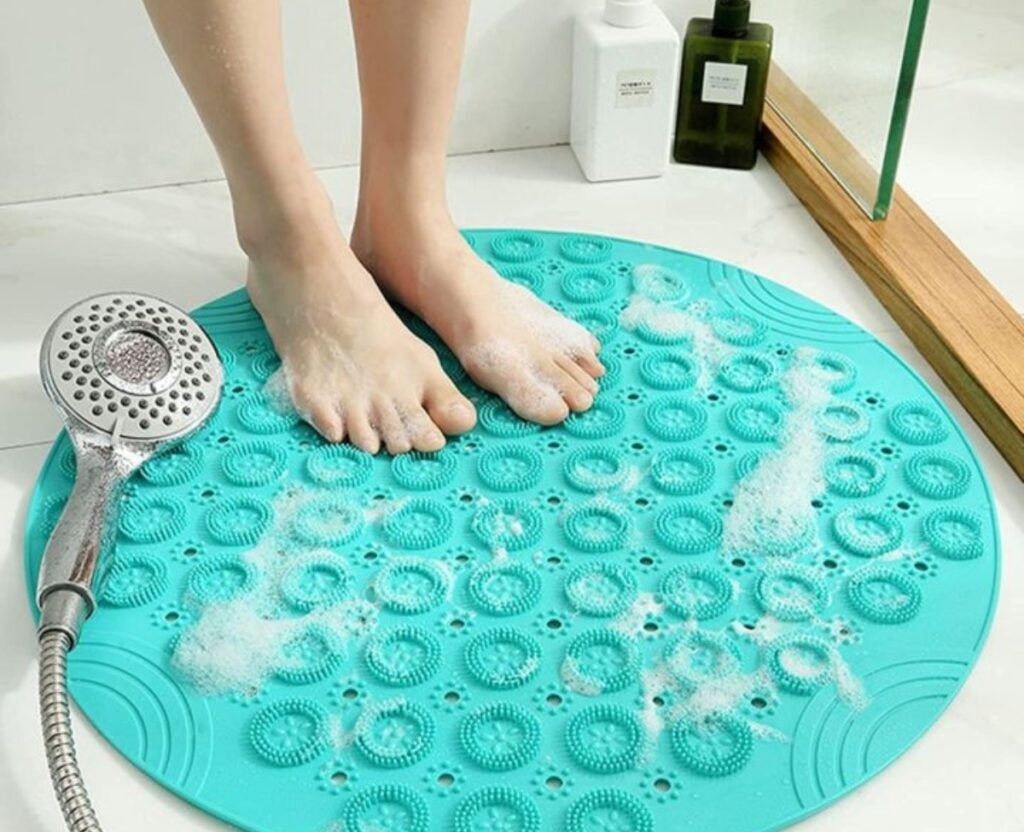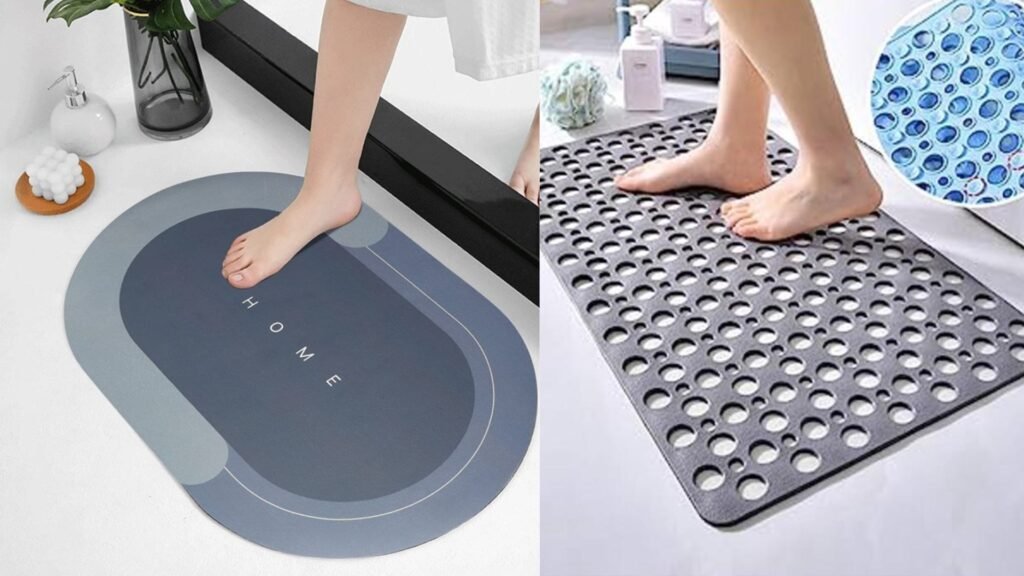Shower mats for tiled floors are specialized safety devices designed to prevent slips and falls in wet bathroom environments. These mats feature non-slip surfaces, suction cup systems, and drainage capabilities that work specifically on smooth tile surfaces. They transform dangerous, slippery shower floors into secure spaces for daily bathing routines. Modern shower mats combine safety technology with style to match any bathroom decor.
Research reveals bathroom falls cause over 234,000 emergency room visits each year in the United States alone. Safety analysts emphasize that ceramic and porcelain tiles become extremely hazardous when wet due to their smooth surfaces. Studies show that proper shower mat installation reduces slip-and-fall risks significantly, particularly for vulnerable populations like children and elderly individuals. Previous research indicates that mats with multiple suction cups provide superior grip compared to basic alternatives. Medical professionals consistently recommend shower mats as essential safety equipment for all tile-floored bathrooms.
Your morning shower shouldn’t feel like a dangerous obstacle course. Picture stepping confidently onto a secure surface that grips your feet while water flows safely around you. The right shower mat eliminates that heart-stopping moment when your foot starts to slide on wet tile. This simple addition to your bathroom routine creates peace of mind that lasts all day. Smart homeowners invest in shower safety before accidents happen, not after. This guide covers everything you need to know about choosing shower mats for tiled floors. You’ll learn about different materials, safety features, and installation tips. We’ll explore top-rated options that combine safety with style to match your bathroom decor.
Why Tiled Shower Floors Need Special Mats
Ceramic and porcelain tiles become extremely slippery when wet. This creates dangerous conditions, especially for children and elderly family members. Standard bathroom rugs don’t work inside shower stalls. This leads to mold growth and creates an even more hazardous surface. Shower-specific mats solve these problems with specialized designs.
Safety statistics show bathroom falls account for over 234,000 emergency room visits annually. Most of these accidents happen in bathtubs and showers. Installing proper shower mats reduces slip-and-fall risks significantly.

Essential Features for Tiled Floor Mats
Non-Slip Surface Technology
The top surface needs texture to provide grip. Look for mats with raised bumps, ridges, or pebbled patterns. These features create friction between your feet and the mat surface. The more contact points, the better the traction. Memory foam mats offer exceptional grip through their cushioned surface. The material conforms to your feet, creating maximum contact. This reduces pressure points while providing stability.
Suction Cup Systems
These cups create a vacuum seal that prevents sliding. This extensive coverage ensures the mat stays in place during use. Heavy-duty suction cups work better than thin, weak alternatives.
Drainage Design
Water must flow freely through or around the mat. Drain holes prevent water pooling, which causes slipping hazards. They also promote faster drying and reduce mold growth. Strategic hole placement matters. Too few holes trap water underneath. Too many holes weaken the mat’s structure. The best designs balance drainage with durability.
Material Quality
Durable materials withstand daily use and harsh bathroom conditions. They resist mold, mildew, and bacterial growth. Quality materials also maintain their grip over time without deteriorating.
Top Materials for Tiled Shower Mats
PVC and Vinyl Options
PVC mats offer excellent value and performance. The SIXHOME Non-Slip Shower Mat exemplifies quality PVC construction. Its loofah-like texture offers a comfortable grip. The 17″ x 30″ size fits most standard showers perfectly. This flexibility helps them conform to slight irregularities in tile surfaces. The result is better suction and more secure placement.
Rubber Construction
Rubber provides natural slip resistance and durability. It’s inherently antimicrobial, which helps prevent bacterial growth. Rubber mats typically last longer than other materials. Natural rubber offers superior grip but costs more than synthetic alternatives. Synthetic rubber provides good performance at lower prices. Both options work well on tiled surfaces.
TPE (Thermoplastic Elastomer)
It’s softer than PVC but more durable than pure rubber. This material is also eco-friendly and recyclable. TPE mats feel more comfortable underfoot. They provide cushioning that reduces fatigue during longer showers.
Interlocking Tile Systems
Modular tile systems let you customize coverage for any shower size. Individual tiles connect to create seamless surfaces. You can replace damaged sections without replacing the entire mat. These systems work especially well for large walk-in showers. They’re available in various colors to match bathroom decor.
Size and Fit Considerations
Standard Shower Dimensions
Most shower stalls measure 32″ x 32″ or 36″ x 36″. Rectangle mats sized 30″ x 16″ fit well in standard tubs. Smaller square mats work for compact stall showers. Measure your shower floor before shopping. Account for any raised edges or fixtures that limit usable space. The mat should cover high-traffic areas without interfering with shower doors.
Custom Sizing Options
Some manufacturers offer custom sizing for unusual shower configurations. This ensures proper coverage for any bathroom layout. Extra-large mats suit oversized showers and walk-in designs. The OTHWAY Extra Large mat measures 47″ x 32″ for maximum coverage. This size works well for accessibility showers and luxury bathrooms.
Overlap Considerations
Mats should extend beyond the shower’s wet area when possible. This provides a safe footing when entering and exiting. Overlap also helps catch water that splashes outside the main shower zone.
Installation and Maintenance Tips
Proper Installation
Clean the tile surface thoroughly before installation. Remove soap residue and mineral deposits that prevent suction. Use a mild cleaner and rinse completely. Press each suction cup firmly to eliminate air bubbles. Start from one end and work systematically across the mat. Proper installation prevents premature lifting and sliding.
Regular Cleaning
Clean mats weekly to prevent the buildup of soap scum and bacteria. Use warm water and mild soap for routine cleaning. Avoid harsh chemicals that can damage the material or reduce suction. Deep clean monthly with a mixture of vinegar and water. This removes mineral deposits and kills bacteria. Rinse thoroughly and allow complete drying before reinstalling.
Replacement Schedule
Even quality mats wear out over time. Replace mats when suction cups lose effectiveness or surfaces become smooth. Typical lifespan ranges from one to three years, depending on usage and quality. These indicate it’s time for replacement. Don’t risk safety by using worn-out mats.
Special Considerations for Different Users
Child Safety Features
Children need extra protection from slips and falls. Look for mats with fun designs that encourage use. Bright colors and patterns make shower time more enjoyable while improving safety. Consider mats with softer surfaces for sensitive skin. Memory foam options provide cushioning that protects knees during bath time. Ensure adequate coverage for active children who move around frequently.
Elderly and Mobility Concerns
Seniors require maximum safety features and ease of use. Extra-large coverage provides stability for those with balance issues.
Cushioned surfaces reduce joint stress and provide comfort. Consider mats with handles or grab strips for additional support. Easy-clean surfaces reduce maintenance burden.
Accessibility Requirements
ADA-compliant showers need specialized mat solutions. Roll-in showers require shower mats that don’t create tripping hazards. Look for low-profile options with beveled edges. Ensure mats don’t interfere with shower chairs or mobility aids. Modular systems allow customization around equipment. Consider professional installation for complex accessibility needs.
Conclusion
Shower mats safety continues evolving beyond basic slip prevention. Smart materials now respond to temperature changes, providing visual warnings when surfaces become dangerous. Antimicrobial treatments are becoming standard, not premium features. The real breakthrough lies in understanding that perfect shower safety isn’t about finding the “best” mat. It’s about matching the right features to your specific needs, usage patterns, and physical requirements. A premium mat that doesn’t fit properly provides less safety than a basic mat installed correctly.
Tomorrow’s bathroom safety will integrate mats with shower design from the beginning. Instead of adding safety as an afterthought, new construction will feature textured tiles, integrated drainage, and built-in grip systems. Until then, the simple shower mat remains your most effective defense against one of the home’s most dangerous daily activities. Your investment in shower safety pays dividends beyond preventing falls. It provides peace of mind that transforms your bathroom from a source of worry into a true sanctuary of relaxation.

